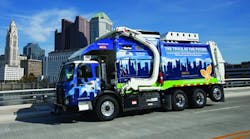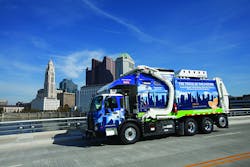A standard recently proposed by the U.S. Environmental Protection Agency (EPA) calls for large diesel-powered vehicles (e.g., refuse trucks) manufactured from 2021-2027 to use 16% to 24% less fuel, depending on their size, by 2027. Trucks that use the RunWise hydraulic hybrid-drive transmission from Parker Hannifin Corp. are reported to surpass this fuel-economy standard twofold, reducing fuel consumption by 43% versus conventional diesel-fuel refuse haulers.
The RunWise transmission has also been approved by the California Air Resources Board. The technology is being looked at to improve fuel economy and efficiency in California refuse fleets by up to 50%, when paired with Cummins Engine Co.’s 2015 model-year engine.
The hybrid-drive transmission reuses as much as 71% of braking energy for propulsion to reduce fuels and CO2 emissions. It’s powered by a three-speed power-drive unit with integrated traction control and end-user diagnostic capability. In addition, the transmission integrates with existing ABS systems and has a single-point electrical interface to the chassis.
“Since introducing the 18 RunWise-equipped refuse trucks into our fleet two years ago, we’ve experienced tremendous savings on fuel consumption of 47% and estimate paring pollutants by more than 5,300 tons over a 10-year span,” says Daryl Greenlee, fleet manager for the City of Orlando, Fla. “The technology continues to play an important role in achieving our Green Works Orlando goal to upgrade our entire fleet with sustainable green technology.”


